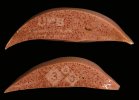Gastric ulcers
Gastric ulcers are common and are characterized by pale, anemic pigs with bloody feces.
Information
Erosion and ulceration of stomach mucosa is a very common affliction in pigs. It occurs where the esophagus meets the stomach. In the early stages of the disease, this area becomes rough and changes gradually as the surface erodes until it ulcers. It can lead to intermittent bleeding that results in anemia or it can cause deadly, massive hemorrhaging. The incidence in sows is usually less than 5% and in growing pigs can be up to 90%.
Symptoms
Symptoms depend on the severity of the condition.
With the more chronic disease:
- Pale skin.
- Weakness.
- Teeth grinding due to stomach pain.
- Dark feces with digested blood.
- Animals go off feed.
- Vomiting.
- Shrunken abdomen.
With acute disease.
- Previously healthy looking animals are found dead and very pale.
Causes / Contributing Factors
Usually there is more than one cause which could include nutritional factors, physical properties of the feed, and faults in management that result in stress and infections.
- Low-protein diets.
- Low-fiber diets. Use of straw reduces incidence.
- High-energy diets.
- Wheat levels over 55%.
- Vitamin E or selenium deficiencies.
- High copper levels in the diet, especially with low zinc levels.
- High unsaturated fat levels in the feed.
- Diet particle size (< 400 µm): the more fine the diet is, the smaller the particle size, the higher incidence of ulcers.
- Excessive aggression between sows.
- Increased animal density and pig movement.
- Deficient sow management in stalls, and tethered sows.
- Stress-inducing noises in the farrowing area.
- Irregular feeding patters and lack of feeder space.
- Periods of hunger.
- Low water and feed availability.
- Transportation.
- Environmental temperature variations.
- Breed - occurs more frequent with certain genotypes.
- There is a relationship between pneumonia outbreaks (especially influenza) and the incidence of gastric ulcers.
Diagnosis
Diagnosis can be based on clinical signs and postmortem lesions. Fecal samples can be tested for digested blood or parasites.
Gastric ulcers can be confused with porcine hemorrhagic enteropathy (hemorrhagic bowel syndrome), which normally affects gilts, because it also causes massive intestinal hemorrhage and anemia. Anemia can also be associated with swine eperitrozoonosis, Hyostrongylus rubidus, chronic mange, and nutritional deficiencies.
Control/Prevention
- Move affected animals to a pen with straw bedding, do not tether them, and offer a quiet environment.
- Supply a high-fiber diet containing very digestible ingredients.
- Inject multivitamins, especially vitamin E.
- Evaluate which of the previously mentioned factors should be controlled, especially paying attention to feed particle size.
- Cull severely affected animals.
- Prevent respiratory infections, especially influenza.
- Make sure animals always have fresh feed available.
Atlas of pathology
See images in the Altlas related to Gastric ulcers













